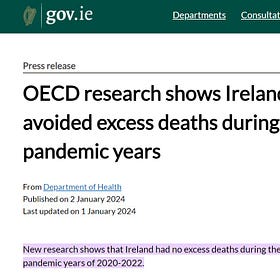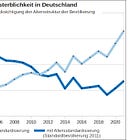Update on my takedown of the Departments of Health’s Orwellian new year messaging on excess deaths in Ireland from yesterday:
Happy New Year
The Irish Department of Health launched its new year (mis)communications with a successful media blitz capturing front page headlines of just about every mainstream national newspaper and media organisation across the island. Its Orwellian new year message puzzlingly contradicted previous wall-to-wall established media coverage during and immediately af…
Worthy of Ridicule
Ughh.. so, this OECD Health Working Paper No. 163 “Examining recent mortality trends – the impact of demographic change” is worse than I initially realised, as is the Department of Health’s spinning of its results.
The Department of Health included in its press release a copy of the following chart for the OECD paper. It seems the government is proffering this as “evidence” for its ridiculous claims the OECD found less than expected deaths in Ireland during the period 2020-2022:
Examining recent mortality trends – the impact of demographic change
Recall, the OECD paper states:
The main objective of the paper is to highlight that many of the conclusions made around the increases in mortality during the pandemic based on simply comparing the number of reported deaths during a period (week, month or year) against a baseline average of the same period in the years prior to the pandemic neglect to take changes in population size and structure into consideration.
Now, despite the authors going to the not-inconsiderable effort of calculating Age-adjusted Standardised Mortality Rates (ASMR) for the pandemic period 2020-2022 and earlier (from 2015), which effectively adjusts for variations in both population size and structure. Despite the OECD authors using the word trend(s) 42 times in the paper, and despite the authors openly discussing the advantages of taking into account longer-term trends1, digging a little deeper reveals they have opted for a simple 5-year average of ASMR from 2015-2019 as their baseline - excuse me while I *face-palm*. From the methodological notes in the annex:
Spot the Trend
In my previous post, I refrained from printing any charts from this paper because I consider the data basis of the OECD’s estimates for Ireland to be so incomplete and inappropriate it would be a waste of my time (and I spotted some Twitter users who beat me to it, anyway). However, in order to highlight this point, let us consider the following plot of the OECD’s ASMR estimate values for only Ireland from Annex B:
Note: average for Ireland’s ASMR for 2015-2019 is 733.

Tell me, can you spot a trend? It doesn’t take an expert in data analysis to recognise that the actual values are significantly above the expected values unless you are somebody who ignores obvious trends and assumes 5-year averages are a better predictive baseline. Actual mortality rates above expected mortality rates is the textbook definition of excess deaths! Please see my translation of Marcel Barz’s takedown of the German Federal Statistical Agency and the inappropriateness of using such simplistic arithmetic averages (or median values) for a population which exhibits such an obvious temporal trend of declining mortality rates.
Witzbold’s Estimates
For what it is worth, here is my own provisional analysis showing raw totals, crude rates, and age-adjusted estimates (standardised to 2022 population). Although adhoc, I am confident my estimates will be borne out as more accurate than anything currently proffered by the Irish government, OECD, EuroMOMO, Eurostat, CSO, HSPC, etc.:
(Please note, if anything, my estimates should be considered conservative, i.e. they will most likely be surpassed by the time death totals for the years 2021-2023 are completed)
Bottom Line
Ireland’s age-adjusted mortality rates had been falling for over a decade until 2018/19, a mortality year of less-than-expected deaths. The following 2019/2020 mortality year’s increase reflected a reversion to trend (slightly above) and 2020/21 continued the decline (again minimal excess deaths). However, starting in summer 2021 there is a reversal of trend and mortality rates began to climb. Even the OECD authors have highlight this unexpected phenomenon across the OECD member countries (although they have unfortunately not used mortality years). This should have been the main takeaway from their working paper [emphasis by Witzbold]:
Most countries that were heavily impacted by the pandemic saw a notable rise in mortality rates in 2020 and/or 2021 and therefore may have expected sharp falls in 2022 to return to pre-pandemic levels. Instead, in 4 out of 5 OECD countries, mortality rates in 2022 remained higher than the average of the five years prior to the onset of the pandemic. Against the general decreasing trend in mortality in many countries pre-pandemic, only Luxembourg had a mortality rate in 2022 lower than that observed in 2019. On average, mortality rates in 2022 remained 6% higher than in 2019, and in seven OECD countries it was more than 10% higher.
It has been taking much more of my free time compiling these posts trying to combat the mis- and disinformation swirling around Ireland’s excess mortality figures than anticipated. If you could share my posts widely and help my work reach a larger audience, I would be very grateful:










